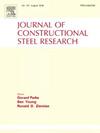Shear performance of circular and rectangular concrete-filled double-skin steel tubes (CFDSTs)
IF 4
2区 工程技术
Q1 CONSTRUCTION & BUILDING TECHNOLOGY
引用次数: 0
Abstract
With the advancement of megawatt (MW)-level wind turbine towers, traditional steel pipe structures no longer meet the requirements for large-scale wind turbine towers. Concrete-filled double-skin steel tubes (CFDSTs) is a potential structural form with expanded sections, high bending stiffness, light weight, and good seismic performance. However, it is prone to experience shear, flexural, shear-flexural, and torsion complex loading conditions caused by accidental loads. Currently, experimental studies on the shear performance of CFDSTs are still few. The influence mechanisms of the hollow ratio (χ) and the shear-span ratio (m) are unclear, with immature calculation methods. Therefore, this paper investigates the shear performance of circular and rectangular CFDSTs. A total of 15 circular and 8 rectangular CFDSTs are tested. The experiments primarily examine the influences of χ and m on failure modes, load-displacement relationships, and strain. Experimental results demonstrate a transition from shear-dominated to flexure-dominated failure modes as m increases, with local buckling exacerbated by higher χ due to reduced concrete cross-sectional area. Shear capacity decreases with rising χ and m, though flexural stiffness partially mitigates this reduction at larger m. Simultaneously, corresponding finite element (FE) models are established to thoroughly analyze the shear capacity mechanism of CFDSTs by exploring the logarithmic strain distribution, load distribution of each component, and contact stress. Finally, the shear capacity calculation methods are provided for circular and rectangular CFDSTs, which considers χ, m, and the constraint effect factor (ξ).
求助全文
约1分钟内获得全文
求助全文
来源期刊

Journal of Constructional Steel Research
工程技术-工程:土木
CiteScore
7.90
自引率
19.50%
发文量
550
审稿时长
46 days
期刊介绍:
The Journal of Constructional Steel Research provides an international forum for the presentation and discussion of the latest developments in structural steel research and their applications. It is aimed not only at researchers but also at those likely to be most affected by research results, i.e. designers and fabricators. Original papers of a high standard dealing with all aspects of steel research including theoretical and experimental research on elements, assemblages, connection and material properties are considered for publication.
 求助内容:
求助内容: 应助结果提醒方式:
应助结果提醒方式:


